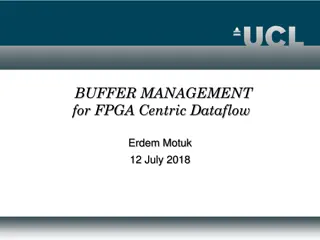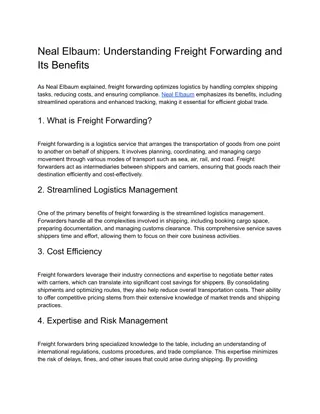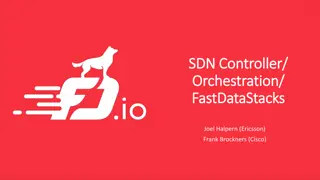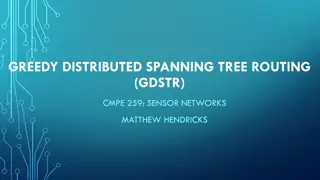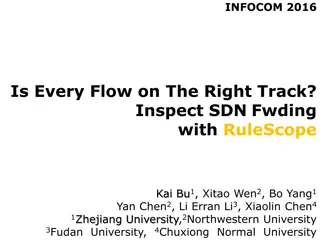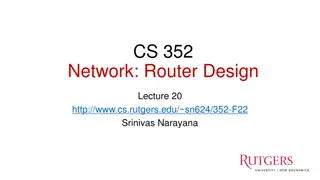Evolved Addressing and Forwarding in Information-Centric Networks
The content discusses Evolved Addressing and Forwarding in Information-Centric Networks, focusing on an accountable Internet protocol (AIP) that addresses vulnerabilities at the IP level, such as source spoofing, DoS attacks, and route hijacking. AIP utilizes a hierarchy of self-certifying addresses derived from public keys, aiming to enhance accountability in Internet communications. The design of AIP includes hierarchical addresses, Accountability Domains (ADs), and Endpoint IDentifiers (EIDs) to ensure global uniqueness and address scalability challenges. Overall, this approach explores novel methods to secure and streamline Internet operations.
Uploaded on Oct 02, 2024 | 0 Views
Download Presentation

Please find below an Image/Link to download the presentation.
The content on the website is provided AS IS for your information and personal use only. It may not be sold, licensed, or shared on other websites without obtaining consent from the author. Download presentation by click this link. If you encounter any issues during the download, it is possible that the publisher has removed the file from their server.
E N D
Presentation Transcript
Information-Centric Networks Section # 7.3: Evolved Addressing & Forwarding Instructor: George Xylomenos Department: Informatics
Funding These educational materials have been developed as part of the instructors educational tasks. The Athens University of Economics and Business Open Courses project only funded the reformatting of these educational materials. The project is being implemented as part of the Operational Program Instruction and Lifelong Learning and is co- financed by the European Union (European Social Fund) and national funds.
Licencing These educational materials are subject to a Creative Commons License.
Week 7 / Paper 3 Accountable Internet Protocol (AIP) Michael Walfish, Hari Balakrishnan and Scott Shenker David G. Andersen, Hari Balakrishnan, Nick Feamster, Teemu Koponen, Daekyeong Moon, Scott Shenker ACM SIGCOMM 2008 Main point Accountability at the forefront of the Internet Prevention of source spoofing, DoS, route hijacking, route forgery AIP uses a hierarchy of self-certifying addresses Each component is derived from a public key Information-Centric Networks 07c-4
Introduction The Internet is rife with IP level vulnerabilities Misconfigured routers wreak havoc on packet delivery Hijacked routes used to send untraceable spam Hijacked hosts spoof source addresses DoS attacks occur on a daily basis Many solutions proposed, but all have shortcomings Complicated mechanisms that change the Internet model External sources of trust to certify BGP updates Operator vigilance to keep updating filters Maybe the fundamental architecture is at fault AIP uses self-certifying flat addresses Hosts can prove they own an address without a PKI But, flat addressing is a scalability challenge Information-Centric Networks 07c-5
AIP design Basic structure and function Hierarchical addresses with two or more components Each network is divided into Accountability Domains (ADs) Each host is an Endpoint IDentifier (EID) Both AD and EID are globally unique Addresses have the form AD:EID ADs may be subdivided into units In general addresses are AD1:AD2: :ADk:EID The AD and EID is the hash of the public key of an entity Each component is 160 bits long (8+144+8) Direct link between identity (public key) and name (AD/EID) Each AD/EID has the form Version:Key Hash:Interface Version indicates the scheme used to generate the AD/EID Interface indicates one of the interfaces of a host Information-Centric Networks 07c-6
AIP design Forwarding and routing Each packet contains source and destination AD:EID Multiple AD levels are treated as a stack Forwarding proceeds towards the current AD Border routers switch to the next AD in the stack Interdomain routing can use BGP or any other protocol Routers advertise reachability to ADs, not prefixes ADs can be grouped into ASes if needed DNS and mobility A multihomed host will have different ADs but the same EID Transport protocols bind to the EID, not the AD Mobile hosts need to change their AD only Changes can be authenticated since EIDs are bound to keys Information-Centric Networks 07c-7
Uses of accountability Source accountability (no source spoofing) Common source spoofing variants Pretending to be a host at another network Pretending to be another host at your network Creating large numbers of unused addresses EID verification: at first hop router On reception of data from unverified host Drop packet and return verification packet V V contains source/destination addresses, packet hash and interface V is signed using a secret that changes regularly The sender returns V signed with its private key The router verifies the signature and if correct passes next packets Replay attacks at the router prevented by the secret Replay attacks at the sender prevented by inserting random packet ID Only the sender needs to cache hashes of recent packets Information-Centric Networks 07c-8
Uses of accountability Source accountability (no source spoofing) AD verification (at AD boundaries) On reception of packet from AD B, AD A checks that: If B is trusted to check packets, forward it Otherwise check if the packet is on the route to the source Otherwise drop packet and verify the source as with the EID The last step allows multihoming and asymmetric paths Ensuring scalability at border routers Only packets that arrive from an unexpected route are remembered If the AD:EID pairs for the same AD are many, use a wildcard AD:* This is dangerous if an attacker controls some hosts in the AD It can force the border router to insert a wildcard Limiting address minting Routers can limit the number of new EIDs they accept per minute Similarly for ADs in border routers Information-Centric Networks 07c-9
Uses of accountability Shut-off protocol Requires a smart-NIC that rate-limits transmission if needed The NIC records hashes of recently sent packets It also accepts Shut-Off Packets (SOPs) independently A SOP contains a packet hash and a TTL, signed by the destination The NIC accepts the packet if it contains a valid hash and signature Then it shuts-off traffic for the TTL The random packet ID prevents replay attacks Hashes of thousands of packet can be kept in a Bloom filter Securing BGP BGP peering sessions are encrypted with AD public keys BGP routers sign their routing announcements Routers only need to know the public keys of other ADs Information-Centric Networks 07c-10
Routing scalability Routing growth estimates The AS diameter increases slowly (less than 5 hops) Routing tables grow 17% per year (about 1.6 million in 2020) Routing traffic grows linearly with table size Estimate 1.5 updates per day per prefix Effects of moving to AIP RIB/FIB size increase due to 160 bit AD and 2048 bit public key Doubles for two level ADs BUT: lookups are flat, not longest prefix Estimated 80% reduction in memory accesses The AS diameter may grow by 2-3 hops due to two level ADs CPU costs that same as those needed for S-BGP Information-Centric Networks 07c-11
Routing scalability Semiconductor growth trends Assume the ITRS roadmap of density doubling every 3 years Resource requirements RIB (DRAM): Roughly triple the amount of RAM needed by IP No problem with current growth trends FIB (DR/SR/CAM): SRAM will grow much faster than FIBs CPU: Loading time of tables to memory Estimated to be less than 30 seconds Cryptography: 66 seconds for all tables May need acceleration as it is slower than the loading time Information-Centric Networks 07c-12
Key management Key compromise: what if a private key is exposed? Key revocation is tricky but feasible The biggest problem is the false confidence in lost keys Therefore mechanisms for rapid loss detection are needed Public registries for ADs are needed They only store self certifying data (no PKI needed) Can be automatically populated (no human intervention) Local (per domain) and global registries possible Types of information stored in registries Identity/public key pairs Revoked public keys, signed by private keys (write once!) Peering relationships, signed by both peers Certificates binding EIDs to ADs (may be multiple) Certificates binding EIDs to first hop routers (can be multiple) Information-Centric Networks 07c-13
Key management Maintaining domain registries Domains should be forced to sign AD:EID to get it into DNS Hosts check the registries of the domains hosting them Domains check the registries of their peers Key discovery: what is the destination address? Use DNS and verify keys against AD identifiers Establish out-of-band trust between peering domains Cryptographic algorithm compromise This is why version numbers are added to identities New algorithms can co-exist with older ones A version number indicates a hash/sign combination pair Information-Centric Networks 07c-14
Traffic engineering and AD size Traffic engineering maps offered load to a set of paths Performed by DNS and selective prefix advertising ADs cannot be split to smaller prefixes for control But they can be split hierarchically AD granularity: a set of hosts under common administration Splitting ADs for traffic engineering can be done It is aggregating these prefixes that is impossible! Experiments show that such aggregation is quite rare Another possibility is to use the interface bits Each interface could be advertised separately Allows aggregation by zeroing out the interface bits DNS load balancing does not change The interface bits can make it easier Information-Centric Networks 07c-15
End of Section # 7.3 Course: Information-Centric Networks, Section # 7.3: Evolved Addressing & Forwarding Instructor: George Xylomenos, Department: Informatics








